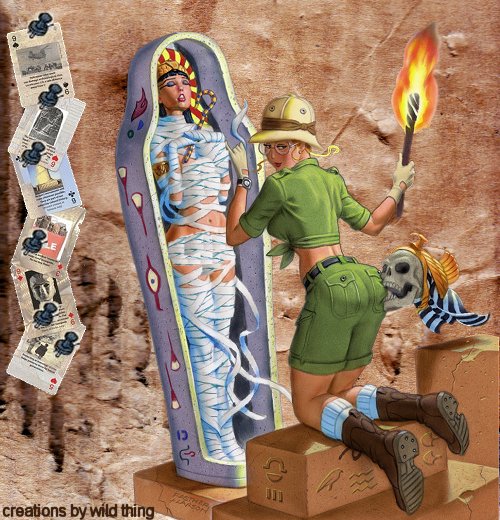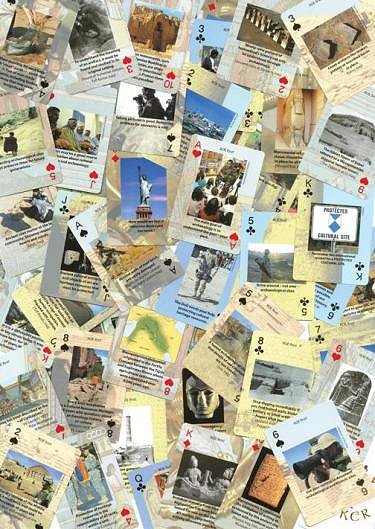
.
Below are two examples of the playing cards in the U.S. military deck on achaeological preservation.


FORT HUACHUCA
Sierra Vista Herald
GIs have a new deck of cards, but it’s more than just for games.
The playing cards are being used as an avenue to teach soldiers the importance of protecting heritage sites in Iraq and Afghanistan.
In the two battleground areas, there are hundreds of sites that go back thousands of years, and America’s armed force members need to know the importance of protecting those areas, said Laurie Rush, cultural resource manager at Fort Drum, N.Y., and one of the leaders in developing the decks of playing cards for the Department of Defense.
“We are using archaeology as tool to help win hearts and minds of Iraqis and Afghans,” she said over lunch last week at the culture summit held by the Intelligence Center and Fort Huachuca.
To her, understanding a nation’s heritage is one of the key factors in appreciating a culture.
Rush calls herself a social scientist with an interest in ensuring today’s generation saves what generations of the past developed. She has a bachelor’s degree in anthropology from Indiana University at Bloomington, a master’s degree from Northwestern University in archaeology and a doctorate in medical anthropology from Northwestern.
There are 119 known archaeological sites in Iraq, 160 in Afghanistan and an untold number of others yet to be discovered, she said.
While war is destructive, care must be taken to ensure sites are protected from destruction, Rush said.
And in Iraq, much of western civilization is tied to sites like Babylon that are mentioned in the Bible, she said.
Many American soldiers are Christian and know Bible stories. Rush said the object is to help instill in them and others the importance of protecting so much that is part of civilization.
As forces move through the desert, they are traveling over areas that have been part of civilization for untold centuries, she said.
To some, there may be no signs of civilization, but “the desert is not empty,” Rush said.
Some archeological sites are easy to see. They have tell-tale signs of human occupation. But, Rush said, more is underground, and those areas can be destroyed as soldiers dig to make protective areas for their camps and even when creating slit latrines during operations.
What is beneath the surface is as important as some above ground site, such as a building.
In the Middle East, mounds called tells look like places with just dirt, but most of them are manmade.
In the deck of the cards, the 10 of spades shows a photo Tell Rimah in Iraq with the words, “A mound or small hill in an otherwise flat landscape could be a sign of ancient human occupation, proceed with caution.”
The cards were developed to allow soldiers to relax while being educated.
During the early part of the Iraq war a deck of cards with the 52 most wanted Iraqi supporters of Saddam Hussein, including him, were pictured to help GIs know who the wanted were.
With the heritage site cards, each suit highlights specific areas, with spades being about digging, diamonds about artifacts, hearts about respect and clubs about preservation.
The 10 of clubs shows a bulldozer at work with the words, “Heavy excavation equipment can do great harm to archeological sites. Be aware and prepare to stop!”
The 10 of diamonds shows an ancient tablet stating, “Mesopotamia is considered the birthplace of writings as evidenced by this ancient clay tablet with cuneiform script.”
The tablet is on the back of every card with words in Arabic and Pashtu reminding the card players to “Respect Iraqi and Afghan Heritage.”
The 10 of hearts shows the large Buddhas in Afghanistan before they were destroyed by the Taliban with the words, “Religious monuments, such as the Bamian Buddhas in Afghanistan, are often targets for intentional destruction. Protect them when possible.”
And each suit is an individual puzzle. Soldiers can arrange them to create an image, once they find the right pattern.
The wild card in the deck states, “Remember!! When artifacts are looted and ruins are destroyed, valuable pieces of the cultural puzzle disappears forever.”
Rush said the object of the heritage resource preservation, which is part of the Department of Defense’s Legacy Resource Management Program, is to support the mission while showing respect.
The enemy will use sites as areas from which to attack, and soldiers can return fire. But, Rush said, the idea is to use only the amount of force needed to protect themselves.
The Department of Defense has taken heat from social scientists and others in academia for not protecting sites and museums. Rush said there has been a turnaround in the complaints as the military works more closely with organizations such as the Archaeological Institute of America and United Nation agencies.
American military installations are helping train GIs in the importance of protecting archaeological sites. Training, which occurs in heritage areas on military post, shows how a mission can be done while not disturbing a region’s history.
On Fort Drum, replicas of what soldiers from the 10th Mountain Division will come upon in Iraq have been built using fake mud bricks purchased from the local Home Depot, Rush said.
As soldiers return from overseas, they also provide information about the differences they have seen, especially in regards to cemeteries, which are different throughout Iraq.
Although she hasn’t been to Iraq or Afghanistan, Rush participated in a Bright Star Operation in Egypt where she and her colleagues were part of the exercise to help military planners and commanders understand the importance of historic sites.
Egypt was a perfect training ground for the program. Like many places where ancient civilizations flourished, one has to be careful where they dig or drive, Rush said.
Some of the best people to approach when involved in operations are the locals, Rush said. Those people know their history and the heritage of the areas.
Archaeology is now part of the military’s global operations guidelines.
In the future, the Defense Department will hopefully establish a Center of Excellence for Heritage Training and Planning, she said.
“We need to use archaeology as one of our combat tools,” Rush said
As part of the Department of Defense’s program to make soldiers, sailors, airmen, Marines and Coast Guardsmen aware of the importance of historic heritage, 60,000 decks of special playing cards have been produced.
Another 50,000 have been ordered by the military’s National Guard Bureau.
Pocket guides about heritage preservation also have been produced, and the Dutch and Austrian military are asking for them to be translated into their languages. The pocket guides also will be produced in Arabic.
The guides provide background on what is an archaeological site and an artifact, and what to do if a site is encountered.
The playing cards and pocket guides remind GIs they must follow the rules of engagement and there can be no collecting, graffiti or vandalism at archaeological sites.

Wild Thing’s comment……..
I think the cards are neat and for sure something for our guys to save. My concern is though I sure as heck don’t want them worrying about the sites on the cards and not themselves being safe. To have to think twice or even ONCE when they need to fire back would make these cards a very bad idea to say the least.

Lessons In The Cards
Bookmarked your post over at Blog Bookmarker.com!
Lessons In The Cards
Interesting. But did the enemy think about us when they fired on us first? No.
We are already being careful enough not to disturb the antiquities of the past in those two nations.
but it’s a nice idea.
I think we just gave the enemy another safe area in which to fire upon our soldiers from: archaeological sites. They already know we can’t return fire if they’re in a Mosque, so now they’ll use these sites.
I can’t help but think of the centuries old Buddhist statues purposely destroyed by the taliban in Afghanistan.
American soldiers are not going to wantonly destroy artifacts any more than they destroy mosques. But if a several muslim asswipers with RPGs and AKs are using a mound for cover, ——tough sh*t!
Nice for a warm and fuzzy, nice thought to protect historical sites but not at the cost of one American or ally life. Some of us remember the Citadel at Hue,yes there were terrorists inside it too and as Tom insightfully points out those Buddhist statues destroyed by the taliban. No sanctuary for terrorists period, hide in a mosque, so long mosque, there is only one way to prosecute war, make it so miserable for the enemy that they will beg for relief. The muzzies have demonstrated that historical sites are meaningless unless it’s Medina or Mecca. With this enemy death is not a factor, it is something else they value more than life, deny them that which they treasure most.
Look on the bright side…….a few well placed explosions might uncover some of these archeological sites that haven’t been discovered yet!!! As well as take out a lot more radical idiots that have no value on life at all!!!
In industry, there is an old adage….if you aren’t willing to fire your most valuable employee for violating a policy, then you have a bad policy. In war, if you aren’t willing to destroy your enemy, then don’t go to war!!!
Our problem is, we have too many wimpy, bleeding heart, liberal assholes undermining our primary goal……..WIN THE F***ING WAR!!!!!!!!!!!!!!!!!!!
Lynn I sure do agree, they don’t care about what they destroy that is ours.
Bob amen to that. And I remember how that al-Sadr’s army bombed a mosque not us nope. They hide out in those places.
Tom, I agree tuff shit! I am sick of catering to these people and they bomb their own places anyway. Plus the way they hide in them and make it even harder for our troops.
Jack I agree, and to make our troops even have to be concerned with this bs is wrong in every way.
I say take the cards, save them and go kill the enemy. If the terrorists hide out in one of the sites so what, this is war and our troops need to go after them.
John…LMAO why yesssss
“a few well placed explosions might uncover some of these archeological sites that haven’t been discovered yet!!”
Hello Wild Thing! Just wanted to say I dig your site! I found you on Woman Honor Thyself and I’ve added you to my blogroll, if you don’t mind. Keep up the good work! Oh, and may I use your little “I’m the God fearing, gun toting, flag waving conservative that liberals warned you about” saying on my site? I’d really appreciate it.
Hi Seane-Anna, nice to meet you, you sure can use it yes. Thank you for adding me to your blog roll I will add you too. I will be adding some things in the next few days and will be sure to do it then.
Thank you so much.
Oh. My. God.
Okay, how about we send her in first. She can protect all those precious sites while our troops stay safe under cover.
Let me just comment on the previous 4 posts:
FUBAR!!
As for your ‘Sarasota Jones’ graphics….
“MUMMY! WOW!!” – Queen of Hearts 2008!
Hi Yankeemom, yes there is a lot of FUBAR with this stuff about how our troops are being treated.
Darth, giggle, thank you. I worked hard on the graphic.
Queen of the Nile: Queen TootsiComeShoppin? Hide her plastic cards Nick? When Frau Vader and I dated in West Germany, the first two VHS-VCR movies we watched were THE ALAMO & CLEOPATRA…. Yes, John Wayne and Richard Burton came through for me… When Hollywood wasn’t HOLLYWEIRDO! I FELL like Davey Crockett and Marc Anthony too.